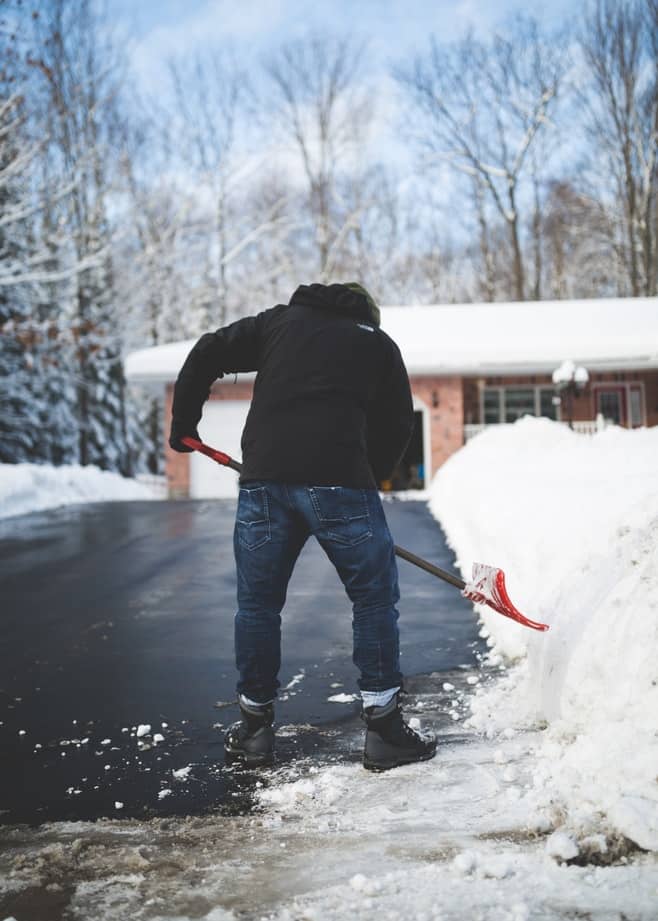Just imagine – you’re waking up in a cozy winter morning, preparing to attend an official meeting. You’re walking towards your garage, and suddenly one glance at your driveway ruins your entire mood.
If you can relate, you’re not a stranger to the hassle caused by heavy snow accumulation in your driveway during winter mornings, on such days, a heated driveway seems to be the ultimate solution to this snow-laden crisis.
Its advanced technology warms the ground surface to a certain extent that prevents the snow from settling on it. But, even though its proven to be highly efficient, people take a step back when they find out its cost.
The common doubts that surround it have people wondering if a heated driveway system is going to be worth the money? Is there a cheaper alternative out there? And, so much more.
So, if you’re having similar doubts, then you should definitely give the following guide a read to know all about it!
Heated Driveway Systems vs. Portable Mats

How do we solve it with a shovel?
Luckily, having your driveway as clean as a slate amidst snowy weather is not impossible, anymore. For those who are not yet aware, heated driveway systems are gradually becoming a common household trend. Popularly known as “snow-melting systems,” heated driveways are giving traditional snow-plowing, salting, and other conventional alternatives a hard run for their money.
In short, a heated driveway system is an artificially heatable ground surface that is installed on a driveway. The exterior, once heated, continues to melt the tiniest snowflake that accumulates over it. Most of us are aware of the severe physical injuries caused by slippery walking surfaces. And, we must ensure the prevention of ice build-up in our driveways and nearby pedestrian areas, especially in the neighborhoods filled with children.
However, affording a typical heated driveway system is nowadays a luxury, considering its sky-rocketing prices. So, what does an average customer with a lesser budget do? The answer is portable heated driveway mats. Comparatively inexpensive and somewhat equal in value, portable mats are an ideal choice for our usual price-conscious customers.
How does a heated driveway system work?
The heated driveway systems are the distant relatives of traditional radiant floor heating systems. We’ve found it to be a safe and time-efficient alternative of snow-removal , featuring a cutting-edge technology.
A clear driveway/porch is just one click away with this. And, once you turn on the driveway heating from inside your room, the system begins to heat up the pavement instantly. It takes nearly 48 volts of energy to turn your driveway into a huge heater element.
Not to forget, the technical design of heated driveways are of two main categories-
-
Electrical current heating
The name here itself is somewhat self-explanatory. Here, the foundation of the surface mattress is a network of numerous electric wires. The design generally circulates insulation of heat that warms the surface from above.
The electric current system is a powerhouse of heat that allows you to crank the temperature over 93.33°C. And, for every foot of linear coil, you get to generate near about 45-50 watts of electricity.
-
“Tubing” heat design
Unarguably the most common heating design amongst radiant driveway systems, this feature has us awestruck! Similar to its alternative, the tubing systems have water tubes fixed underneath. And, warm water is pumped through the attached pipes to insulate the surface.
Fun fact, this system is commonly known as the hydronic snow-removal technique, where the pumped water is also mixed with glycol (antifreeze supplement) to prevent internal freezing. The water is then pumped across the mat, heating the ground surface through the tubing.
This prevents stubborn ice from piling up on the driveway, as it is melted continuously through the heat. The run-off liquid generated by the molten ice is further drained through nearby canals.
The entire heating process is under your control, which allows you to regulate the heat and prevent wastage. However, your budget is a crucial factor in determining the degree of commands you can access in your radiant driveway system.
For example, you can access the manual controls under a tight budget. However, slip in a little more cash, and you can have yourself a fully-automated heated driveway system.

How good is a manual system?
Most of us are often confused about whether to go for a manually-accessed heating system or invest in automated ones. The main question that arises here is whether buying a manual heated driveway system is going to be worth it?
Let’s face it; automation will always have a comparative advantage over manually controlled systems. Although the traditional “on/off” switch can melt the ice significantly, its efficiency in snow-removal is often questioned. Someone new to this may be disappointed by the value they get for their money.
Honestly, the efficiency of manual systems mainly relies on your awareness of the situation and knowing when to start them up. If you can predict a snowstorm and remember to turn on the system on time, you’d be impressed by the end-result this system can produce.
What could be better?
We must remind you again that you shouldn’t expect results as efficient as what the automated systems provide. If you turn on the heating system after the snow has already accumulated over the surface, it will initially melt just one or two layers. And ultimately, you will be left with a massive dead-air space that blocks the snow from the radiated heat.
In most cases, it could take up to an hour to clear the entire pathway. Simply put, it’s rather a less time-consuming alternative to shovel the snow instead of manually heating the surface if you fail to activate it on time.
However, if your budget is low and time is not a huge factor for you, manually accessed systems are still an ideal option to melt the snow.
Why opt for an automated system?
If you are willing to slide in some extra cash to avail exclusive value for your money, always opt for automated systems. In a nutshell, automated systems are the JARVIS to your Tony Stark. What we like the most about automated systems is energy-conservation.
Unlike manually controlled systems, the automated systems are continuously functioning at low-intensity levels. This way, it saves you the hassle of turning on the system every time a snowstorm hits your locality. The heating temperature is automatically increased to considerably higher levels as the surface detects snowing.
So, the automation technology is always alert and efficient at cancelling out every chance of snow accumulation in your driveway/courtyard/porch. Not to forget, the continuous activity of automated sensors prevents it from cold-start issues, which are commonly faced by manual systems.

Things to consider before building a heated driveway
Most of us are eager to install a heated driveway but step back due to the misinformation regarding its costs. Similar to any other technology, this product comes along with considerable installation and operating expenses. Before we discuss costs, let’s look into the factors that together determine the costs of heated driveway installation.
First and foremost, you need to figure out whether you are planning to install an independent heater element or assimilate the driveway with your in-house heating system.
Second, you need to choose between automated and manually controlled systems. As discussed previously, manual systems are comparatively inexpensive. However, automated systems provide you with a sophisticated snow-clearing experience at slightly higher costs.
And finally, ask yourself- will you opt for an electric current heating or hydronic tubing system? Before you make this decision, keep in mind that electric heating systems are initially costly, but require almost zero maintenance after installation. Whereas tubing systems are initially cheaper, but can lead to comparatively higher maintenance costs. Set your priorities before investing.
Most importantly, are you building an entirely new driveway or planning to retrofit your existing driveway? Also, noteworthy to mention, retrofitting your current driveway means a complete teardown of the surface to remove unwanted materials. So, you do have to manage your budget accordingly.
How much does it cost to install a heated driveway?
Generally, constructing a brand-new driveway can be comparatively inexpensive. However, you can manage your bills while retrofitting, by deciding on what needs to be added or removed.
As per Heavenly Heat Inc., the average cost of installation of a heated driveway system will cost you near about $14-$24 per sq. Ft. Now suppose you are planning to build a 20 ft/50 ft heated driveway, then you’ll be paying an average amount of $15,000.
The market price of regular concrete is $120 per c. yard. However, heat-compatible concrete material would cost you around $300 per c. yard.
Coming to the operating costs, one must understand that they are always variable. Mainly, the operating expenses rely on how cold it generally gets during winter in your area. If the weather in your locality is frigid, higher snowfall is naturally guaranteed. And likewise, the operating costs will increase accordingly.
Low snowfall-affected areas such as Richmond can cost you around $0.10-$0.25 per sq. Ft. However, higher snowfall-inflicted areas such as Buffalo can lead to excessive operating costs as high as $0.50 per sq. Ft.
If electricity is considerably expensive in your locality, it is ideal for you to opt for the hydronic tubing system for your driveway. Lastly, you will also have to consider the minor repair/maintenance costs in the long run.

Is a fully built-in heated driveway system worth it?
We understand that it’s one of the most commonly asked questions, considering the high costs involved. “Should I invest my money? Would it be worth the price?”
Yes, a heated driveway system can be pretty expensive. However, we assure you that your investment will be worth it in the long term. And, before we discuss any further, let’s have a glance at the significant benefits availed by installing heated driveways in your residence-
-
Prevention of salt-corrosion
It is a scientific fact that massive accumulation of snow results in heavy piling of sodium chloride in the form of rock salt. Usually, the piling of such de-icers can tamper the condition of the vehicle undercarriages by corrosion.
Installation of a heated driveway instantly melts the heaping snow on the surface, leaving no scope for the accumulation of rock salt. Not only does it ensure the longevity of your courtyard and vehicle, but it also prevents the plants around the surface from burning due to excessive rock salt.
-
Low maintenance
Look at the long-term conveniences, heated driveway systems seldom require maintenance after installation. Not only does it save you an enormous amount of time, but it also protects you from the labor and costs of snow-plowing, salting, or shoveling for years to come. Once installed, all you need to do is turn the power switch on and off. And, that too, only if you have a manual system.
In case you install an automated system, the sensors will take care of the snow accumulation and execute the job automatically.
-
Safety
We are no strangers to the possibilities of accidents on slippery surfaces; and ligament sprains, hypothermia, and injury by fall, are just to name a few. Worst case scenario, you are exposed to higher chances of a heart attack.
Moreover, if you have children in your family, it’s an urgent priority for you to accident-proof your residence. Investing in a heated driveway reduces such risks, ensuring your sound health.
How to install a heated driveway?
Ideally, the installation of snow-melting systems is pre-planned during the construction of hallways. However, we must remind you that building a heated driveway can be a little complex, considering its distinctive compatibility requirements.
If you are planning to install a heated driveway at your residence, you should opt for either asphalt or concrete pathways. In case you have a different driveway plan in your mind, we advise you to take it slow. Discuss the minute details about its advantages and side effects with your contractor.
Mind you; it is not always necessary to build an entirely new driveway to install a heating element. If you already have an existing driveway, do not worry, as retrofitting is still an option.
With proper research and expert assistance, you can always retrofit your existing driveway into a heated surface through tubing or electric heating system installation.
And, especially if you are living in or around Canada, you are familiar with the stress of continuous snow accumulation in the driveway. As per our suggestion, driveway heating by heavenly heat is the best solution to your custom-heated driveway installment requirements. Heavenly Heat Inc. is the ideal option for your cost-effective and energy-efficient snow removal requirements to protect your property from excessive snowfall.
Portable driveway mats- the inexpensive alternative?
We understand that installing a $15,000 heated driveway system is way above most of our budgets. Also, not every one of us has to deal with excessive snowfall. In such cases, installing an entire heated driveway can be a slightly risky and useless investment.
Luckily, heated driveway mats are an uprising trend that gets the job done at a comparatively lesser price. Compared to heated driveways, portable driveway mats are much more flexible. You can place it wherever you want to prevent the accumulation of snow, whether it is your driveway, porch, sidewalks, or even the entrance stairs.
Technically, the portable heating mats comprise the actual heating element sandwiched between two sides of slip-resistant rubbery covers and a moisture-resistant power cord. The heating levels can be customized as per your requirements. So, it’s ensured that you’re not wasting excessive energy while melting ice on the surface.
The more significant advantage of portable mats, as discussed, is the removal of snow from the most required areas, if not entirely. These high-durability products are strong enough to withstand the weight of your vehicle. All you need to do is place the mat over the surface required to pass your car, without being interrupted by snow. Moreover, the portability of the mats allows you to carry it wherever you wish.
This being an affordable alternative, allows one to buy as much mattress surface as required, at a pretty low cost. An average 10’’x30’’ heating mat would cost you around $60. Buy a few, assimilate them through in-built connectors, and boom! You have your heated-up army, eagerly waiting to confront its arch-rival, snow.
What could have been better?
Despite its advantages, we cannot misguide you that portable mats are the perfect alternative to heated driveway systems. For example, portable mats are not nearly as effective as heated driveways, when it comes to the efficient removal of excessive snow. So, if it snows heavily in your region, purchasing portable heating mats will leave you with an unsatisfactory product experience.
Conclusion
Installing a heated driveway system can be slightly expensive, considering its installation and operating costs. Most of us step back when the actual prices are revealed, wondering whether the end product is worth the money.
But, if you peek into the long-term convenience and perks, installing a heated driveway pretty much returns a great value for the money you invest in it.
If you are running short on budget, you can always resort to buying portable heating mats. And, even though that may fall short of a heated driveway system, they will get the job done within a very affordable price range!
Related Articles
11 Best Radiant Floor Heating Systems
7 Best Thermal Leak Detection Kits
13 Best Thermal Imaging Cameras Right Now | Buyer’s Guide
Heated Driveway Systems vs. Portable Mats- Costs and Applications Compared


